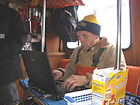

 | |||||||||||||||||||||
|
|
Journals 2005/2006Jeff Manker
August 18, 2005
"Welcome to the Top of the World!" the sign exclaimed. I am here in Barrow, Alaska to help study the effect of climate change on the ecosystem where Bowhead whales live. I am a high school Marine Science teacher from Gilroy, California who was lucky enough to be a part of this scientific expedition. Barrow is not literally the "Top of the World", but as far north as you can go in the United States - three hundred miles north of the Arctic Circle. So, why Barrow? This seems to be the hot spot (no pun intended) for climate change research. The effects of climate change seem to be proceeding at a faster rate here (thinning ice, higher than normal temperatures, melting permafrost, etc.), so scientists from around the world come here to study every aspect of this puzzle. The native people of Barrow, the Iñupiat, have a long tradition of working with scientists, and have provided facilities and expertise at many levels to encourage continuing investigations and research. The project I am working with seeks to integrate many elements of investigation: we will look at historical cyclical oscillations of arctic current and wind patterns that affect the thickness and deposition of sea ice, which in turn influences the aggregation of plankton and the migration patterns of Bowhead whales which the native people depend on for subsistence. The idea is to look at and integrate all of these forms of input to see if a pattern of future change can be determined.
The Principal Investigators (PI's), Carin Ashjian and Bob Campbell and others have been here a few days readying equipment and ironing out logistics. Yesterday several members went to Prudhoe Bay (where Alaskan oil comes from) to load our boat, the R/V Annika Marie, with scientific gear and came 150 miles up the coast to anchor off of Barrow. This afternoon we went to the boat to run a sea test of the sampling gear. The very complex instruments were not cooperating so Bob, Stephen Okkonen, Phil Alatalo and Bill Kopplin (Captain of the Annika Marie) spent many hours connecting instruments to computers and GPS (global positioning system) units while the rest of us held the odd tool, ran back to BASC (Barrow Arctic Science Consortium) for a spool of wire and helped consume all the cookies on board. Bill also treated us to a taste of traditional Iņupiat food. Muktuk is the name for a piece of whale skin attached to the blubber. The muktuk is sliced thin and often eaten raw. The skin feels like an inch thick wetsuit stuck to translucent old Jello. The skin was rather chewy. But the blubber was tender and mild tasting, reminiscent of seaweed. One of the scientists, Steve Okkonen pointed out to me that we were associated with a larger project known as SNACS (Study of the Northern Alaska Coastal System) and that was why we needed to keeps so many snacks handy.
Tonight, on our way back from dinner at Pepe's, the pretty decent Mexican restaurant in town we spotted a spout only fifty yards from shore. We stopped the truck and were lucky enough to see a small (Gray?) whale making its way through the shallow near shore waters! |
||||||||||||||||||||





